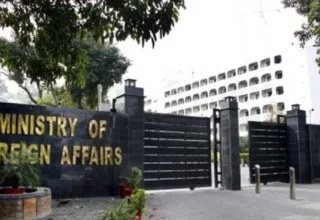
By Mian Abrar
It is shocking for most of the foreign visitors who have only heard of Xinjiang before to step out of Ürümqi Diwopu International Airport and see a completely transformed and bustling city waiting for tourists.
Visits at several locations across Ürümqi indicate that Ürümqi, the capital city of Xinjiang Uyghur Autonomous Region, is one of the most-developed cities in the north-western China.
However, the city was completely different about 15 years ago. My first visit to the Xinjiang Autonomous Regions occurred in August of 2010. Ürümqi, a moderately developed area, was catching up with the rapid development of China’s Northern provinces. The city was a reasonably developed city at the time, while Kashgar and other sections of Xinjiang were struggling to overcome widespread poverty.
In 2016-17, I visited Xinjiang again. Ürümqi was also booming, but it was Kashgar that piqued our interest since the centuries-old city bordering Pakistan’s northern territories had evolved into a new economic hub when China constructed a new city near Kashgar, known as Kashi New Area.
However, Chinese government spent billions of dollars to build a new metropolis in ancient Kashgar to serve as a base for China’s Pakistan Economic Corridor (CPEC), the flagship project of the Belt and Road Initiative (BRI), which was presented by Chinese President Xi Jinping in 2015.
Despite the fact that the development process in Xinjiang had begun, the area experienced an increase in terrorist attacks as opponents of development may have attempted to hinder progress in the Xinjiang Autonomous Regions.
For the following few years, the terrorists made every effort to maintain the region in instability. However, the resolute people of Xinjiang vanquished the radical mindset with the advice and aid of the central government, and the area quickly returned to normalcy by 2017.
A visit to the Xinjiang Counterterrorism and Counter-extremism Exhibition highlighted that Xinjiang has emerged as a significant battlefield in China’s struggle against terrorism and extremism.
“In the name of ethnicity and religion, the religious extremists deceitfully used people’s ethnic identity and religious beliefs to instigate religious fanaticism, spread extremism and incite the common public to join violent and terrorist activities,” a government official told the team that was visiting.
He stated that the Chinese government responded forcefully by addressing both these symptoms, root causes, and implementing preventative measures, establishing vocational education and training centres in accordance with the law to prevent the breeding and spread of terrorism and religious extremism, effectively reducing the frequency of terrorist attacks.
Since then, the people of Xinjiang have followed a path of economic restoration and development, never looking back.
A visit to the Xinjiang Islamic Institute (XII) highlighted how religious principles and Islamic teachings were imparted to seminary students, while young religious scholars were provided with the necessary facilities.
Prof Qamar Din Ahmed, the Institute’s director, stated that the institute and its eight sub-campuses can house 1000 students at a time, and bachelor degrees are granted to students who would subsequently take up duties at local mosques and religious teaching institutes. He stated that the institute promotes a message of peace and fraternity.
Another notable feature is the poverty alleviation drive, which was successfully completed in Xinjiang by the Chinese leadership under visionary Xi Jinping, with nearly 3.09 million destitute people lifted out of poverty, and Xinjiang’s problem with absolute poverty resolved amicably.
It was witnessed this success story in 2016 when I was part of a group that visited residents living in Ürümqi’s slum regions who were being relocated to new flats. The residents in the slums were overjoyed to discover fresh housing.
A new age of agricultural revolution has also begun in Xinjiang, which is endowed with lush fields and powerful rivers. Plains and mountains are now home to blooming fruit and crops, and per-acre yields have increased dramatically owing to contemporary research, hybrid seeds, and efficient fertilizers. Xinjiang, which was previously rich in orchards and cultivatable lands, is now a food basket for China and beyond.
Livestock and dairy products provide additional revenue for the residents of Xinjiang. A visit to Ili Yimuxin Dairy Company Limited in Yining revealed that Xinjiang is China’s first of four golden milk supply belts, as well as the county’s most important dairy producing area.
The region has about 4 million cows, with an average yearly milk yield of 7500 kg per head. Raw milk is an essential dietary component in Xinjiang because it contains a significant amount of high-quality protein.
Xinjiang’s livestock sector contributes significantly to the central government’s ability to supply the demands for dairy products and meat consumption throughout the country.
A tour to the Innovative growth Corridor of the Ürümqi Economic and Technology Development Zone assisted the delegates in understanding the magnitude of the provincial capital’s contribution to economic growth.
The team also went to Xinjiang Software Park, which reflects the growth of the information technology sector in Xinjiang. The vast bazaar of Ürümqi also demonstrates flourishing economic activity, with local traders attracting millions of tourists every day.
The China-Kazakhstan International collaboration Centre in Khorgos represented the central government’s active strategy of promoting trade and collaboration with China’s neighbours. This effort has also assisted residents in upgrading their companies and attracting both local and foreign traders, so boosting the local economy.
With these elements working together, Xinjiang is developing into a vibrant economy. Religious freedom and concord among many ethnic and religious groups are assisting the region in developing a strong and rising economy, and the region will soon become a model of religious tolerance as well as regional commerce and collaboration.
Sooner rather than later, Xinjiang will take centre stage by contributing to the regional commerce hub, which will serve as a pivot for the multibillion-dollar CPEC project, BRI’s flagship.








